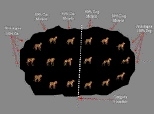CAMBRIDGE, Mass. -- Researchers at the Massachusetts Institute of Technology found that individual neurons in monkeys' brains can become tuned to the concept of "cat" and others to the concept of "dog.
The study suggests that people, too, have individual neurons sensitive to categories of our most familiar things.
This is the first time, the MIT researchers report in the Jan. 12 issue of Science, that individual brain cells have been linked with one of the brain's most important cognitive functions: the ability to instantly categorize what we see.
"This ability is critical for thought. Our raw perceptions of the world would be useless without the meanings we attach to them. Yet almost nothing is known about how the brain accomplishes this," said Earl K. Miller, "Class of 1956" Associate Professor of Brain and Cognitive Sciences in MIT's Center for Learning and Memory.
Knowledge about the cellular basis for this ability may one day be useful in treating disorders in which the brain is unable to assign meaning to the environment. Some disorders involve losing the ability to identify certain objects; others involve disordered thoughts or misjudgments.
CAT-DOGS AND MONKEYS
Miller and Tomaso Poggio, Uncas and Helen Whitaker Professor of Brain and Cognitive Sciences, showed monkeys computer-generated images of generic cats and dogs. The researchers took three prototype cats (a house cat, a tiger and a cheetah), and three types of dogs (a German shepherd, a pointer and a St. Bernard), and morphed, or blended, dog characteristics and cat characteristics into single images.
Some images were 80 percent cat and 20 percent dog, or 60 percent dog and 40 percent cat. When one of these blended images was more than half cat or more than half dog, the monkeys were able to categorize them correctly most of the time. Their specific neurons for "cat" or "dog" lit up appropriately.
"It was a long, slow learning process, but they learned what makes a cat a cat and what makes a dog a dog. They then learned to instantly recognize random blends of cats and dogs," Miller said. "The monkey's individual neurons became sensitive to features that comprise a dog or cat. With enough experience, that happens automatically."
While many animals are born with an inbred ability to recognize a common predator, these monkeys had no prior experience with cats or dogs.
"CATEGORY" NEURONS
The ability to learn whether something we see is a cat, a house or a car allows us to react to our environment quickly and appropriately. This is not just about physical features, but the meaning we assign to objects. For instance, a red billiard ball may look like a red apple, but the two objects fall into very different categories in our minds.
"One of our most fundamental behaviors is to assign meaning to what's around us," Miller said. "When we enter a room, we don't spend a lot of time and effort identifying the objects. We know immediately if something is a chair or a table, and how to use it, even if we have never seen that particular chair or table before."
How is a broad category represented in the brain? "One possibility is that categories could have been encoded by different neurons that represent different physical attributes -- for instance, neurons that recognize shapes and colors and textures could all work together to represent a broad category," Miller said. "Instead, we found that they are represented by neurons 'tuned' to the category. That is, they come to represent the whole category, not just features that make up the category."
MALLEABLE AND CHANGEABLE NEURONS
The researchers also showed for the first time that specific neurons are flexible enough to be assigned to different categories.
At the same time that neurons get assigned to a category, they also are malleable and changeable, and constantly upgrading what concepts include. If an entomologist at first knows only three types of insects and learns to recognize dozens more, her neurons constantly adapt as she learns more categories.
In addition to Miller and Poggio, authors include MIT graduate student David J. Freedman and Maximilian Riesenhuber, postdoctoral fellow in MIT's Department of Brain and Cognitive Sciences.
This work is funded by the National Institute of Neurological Disorders and Stroke, the National Science Foundation and the RIKEN-MIT Neuroscience Research Center.






